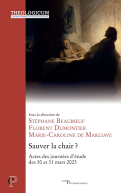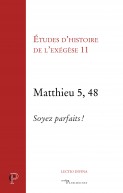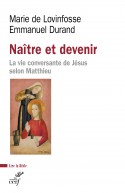
La Montée à Jérusalem
Collection Lire la Bible - N° 161
144 pages - janv. 2010
16,50€
Dans l'évangile de Luc, la « montée à Jérusalem » s'étend sur dix chapitres. L'étude structurelle, mise en œuvre ici sous la forme d'un commentaire suivi, montre qu'en fait il s'agit avant tout d'un voyage « catéchétique », au long duquel l'évangéliste développe les thèmes qui lui sont chers : la première étape s'organise autour du thème de la mission et de la division qu'elle provoque ; la deuxième se concentre sur le renversement qu'induit cette mission sur le plan social, moral et historique ; la troisième et dernière étape, en une série de péricopes reliées par un impressionnant tuilage, précise les modalités du salut auquel donne accès la mission de Jésus. Celle-ci culmine à Jéricho avant de s'achever soudainement sur l'entrée au Temple. Au terme de ce parcours — que Luc a enrichi de ses plus belles paraboles —, nous comprenons mieux le sens profond de l'accueil de Dieu, tel que Jésus l'a annoncé avant de subir lui-même le rejet. Derrière l'accueil des pécheurs, des pauvres et des exclus parmi lesquels Jésus s'est ainsi rangé, l'évangéliste dessine en filigrane l'accueil des païens. De cette manière, la mission des disciples, à laquelle Luc consacrera son second volume (les Actes des apôtres), montre dès le début sa conformité avec celle du Maître.
--
In Luke’s gospel, the ‘road to Jerusalem’ covers ten chapters. This structural study, presented in the form of a commentary, presents this journey above all as a ‘catechismal’ itinerary, during which the evangelist develops those themes that are dear to him. The first stage is constructed around the theme of the mission and the division it provokes; the second focuses on the social, moral and historical upheaval provoked by the mission; the third and last stage, a series of pericopes linked by an impressive polyphony, describes the conditions of a redemption made possible by Christ’s mission. It culminates in Jericho before suddenly ending on the entrance into the Temple. At the end of the journey - which Luke has embellished with his most beautiful parables - readers have gained a better understanding of the deep meaning of receiving God, as Jesus proclaimed before himself suffering rejection. Beyond the reception of sinners, the poor and the rejected - of whom Jesus considered himself to be one - the evangelist sketches the welcome of pagans in the background. In this way, the disciples’ mission, to which Luke devoted his second volume (the Acts of the Apostles), is revealed right from the beginning as being in keeping with the Master’s.
--
In Luke’s gospel, the ‘road to Jerusalem’ covers ten chapters. This structural study, presented in the form of a commentary, presents this journey above all as a ‘catechismal’ itinerary, during which the evangelist develops those themes that are dear to him. The first stage is constructed around the theme of the mission and the division it provokes; the second focuses on the social, moral and historical upheaval provoked by the mission; the third and last stage, a series of pericopes linked by an impressive polyphony, describes the conditions of a redemption made possible by Christ’s mission. It culminates in Jericho before suddenly ending on the entrance into the Temple. At the end of the journey - which Luke has embellished with his most beautiful parables - readers have gained a better understanding of the deep meaning of receiving God, as Jesus proclaimed before himself suffering rejection. Beyond the reception of sinners, the poor and the rejected - of whom Jesus considered himself to be one - the evangelist sketches the welcome of pagans in the background. In this way, the disciples’ mission, to which Luke devoted his second volume (the Acts of the Apostles), is revealed right from the beginning as being in keeping with the Master’s.
- Dimensions : 135x215x8
- ISBN : 9782204091015
- Poids : 210 grammes
DU MÊME AUTEUR
> VOIR TOUS LES LIVRES DE l'AUTEUR
DANS LA CATÉGORIE EXÉGÈSE BIBLIQUE
Le Père peut-il juger ses enfants ?
Essai biblique sur le jugement et la miséricorde de Dieu
de Joseph Chéhab
344 pages - sept. 2016
Naître et devenir. La vie conversante de Jésus selon Matthieu
d' Emmanuel Durand ,Marie de Lovinfosse
280 pages - mai 2021







